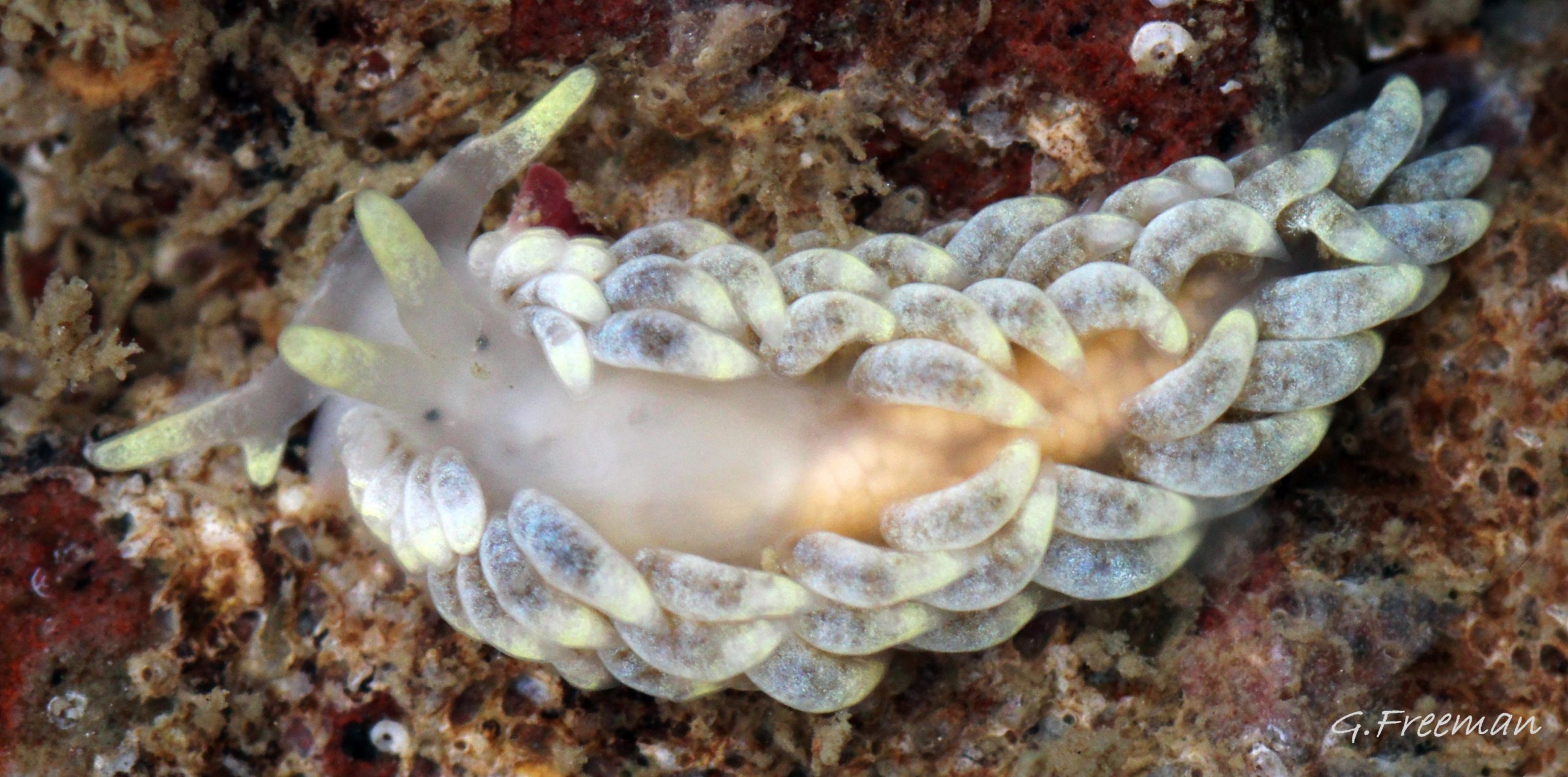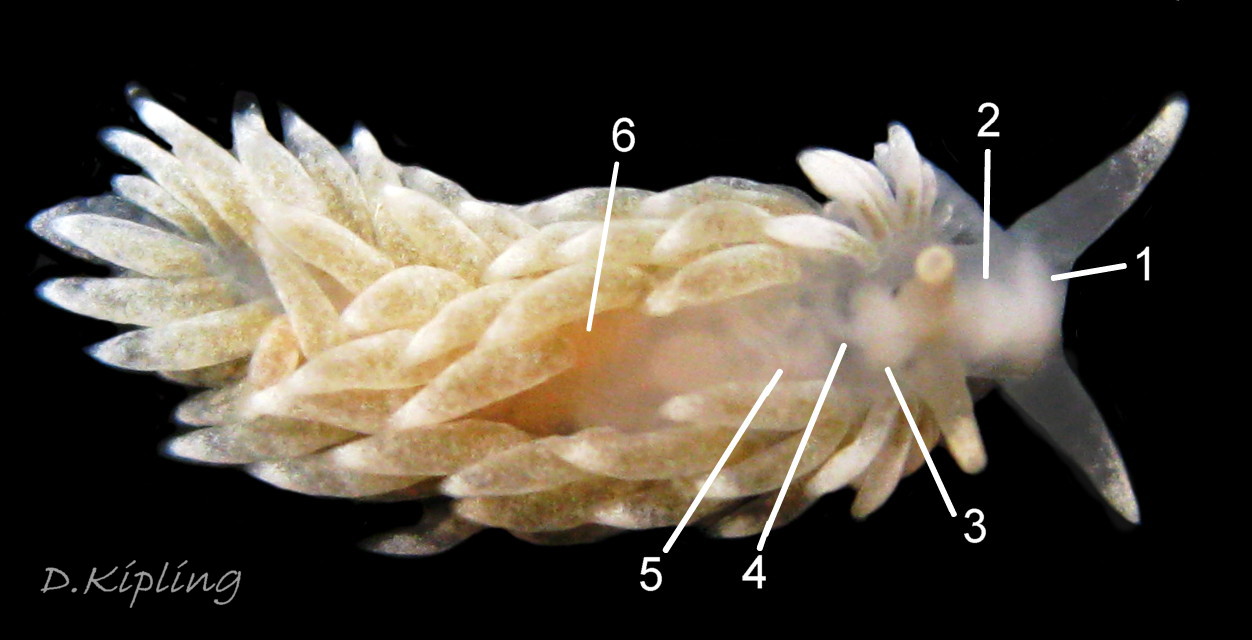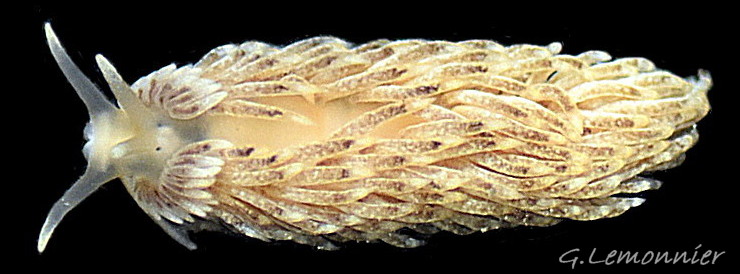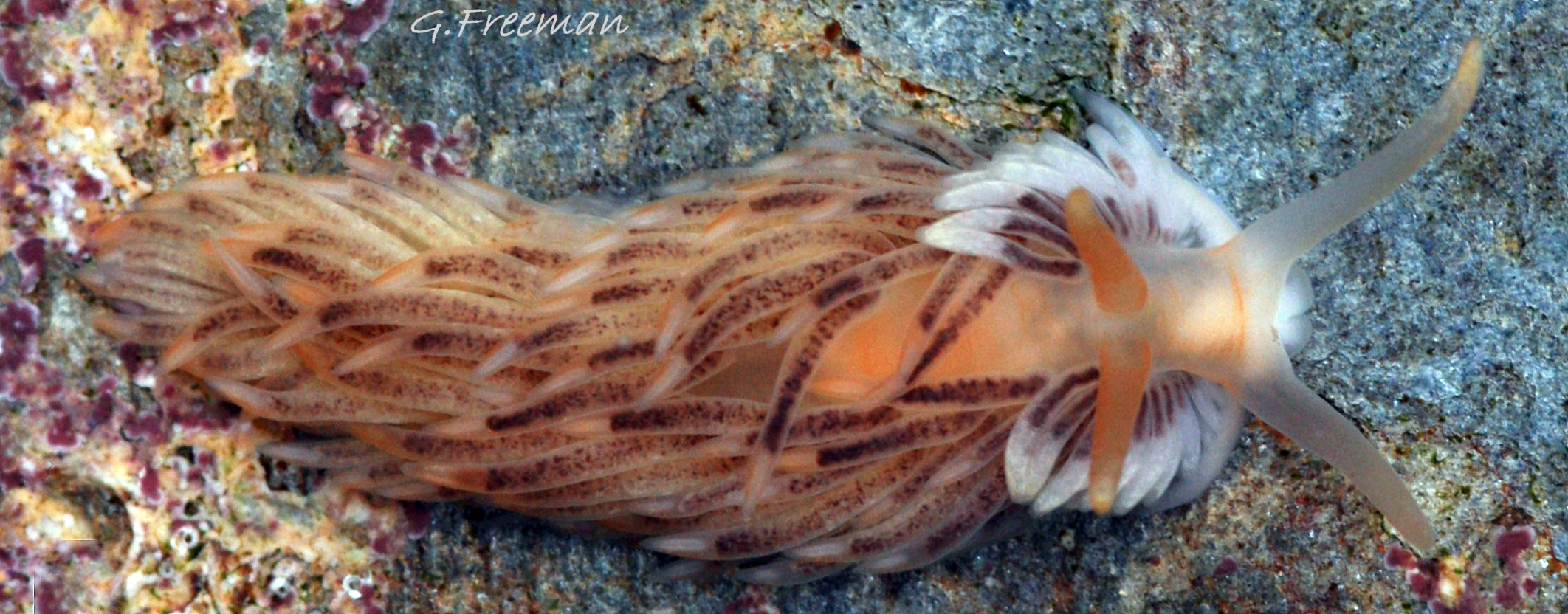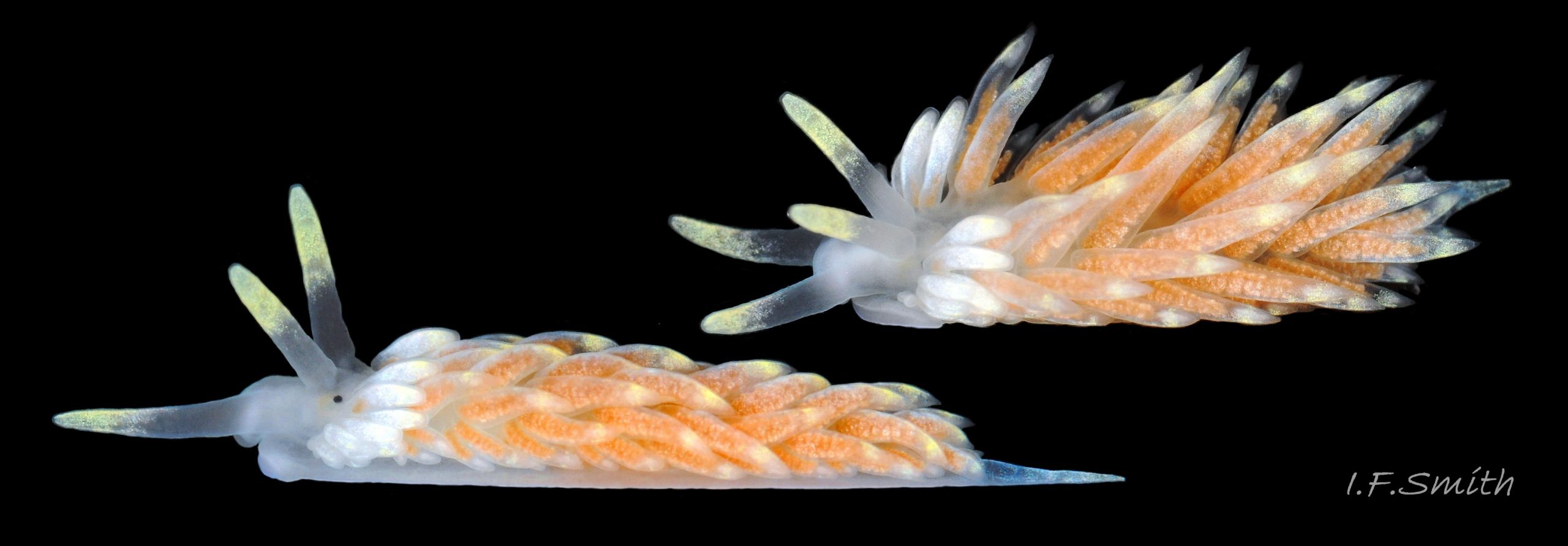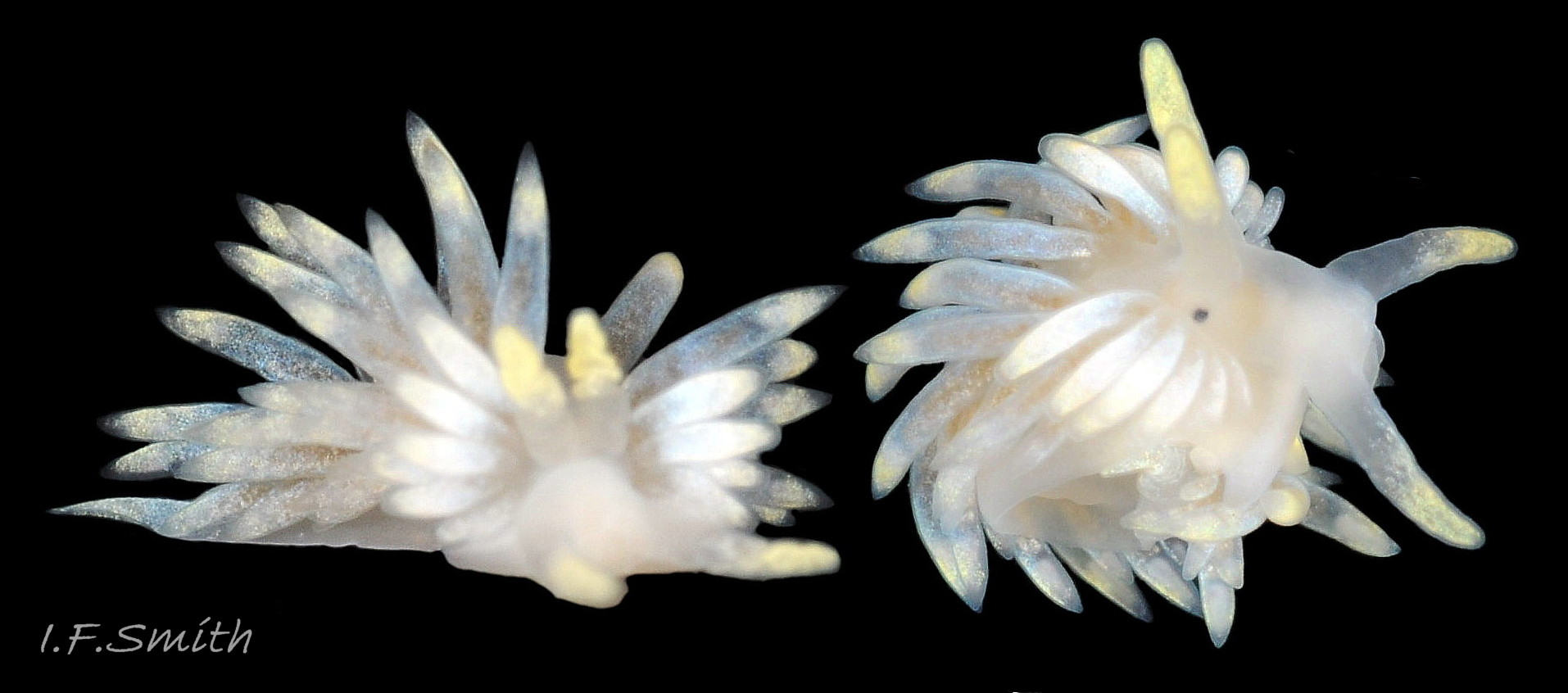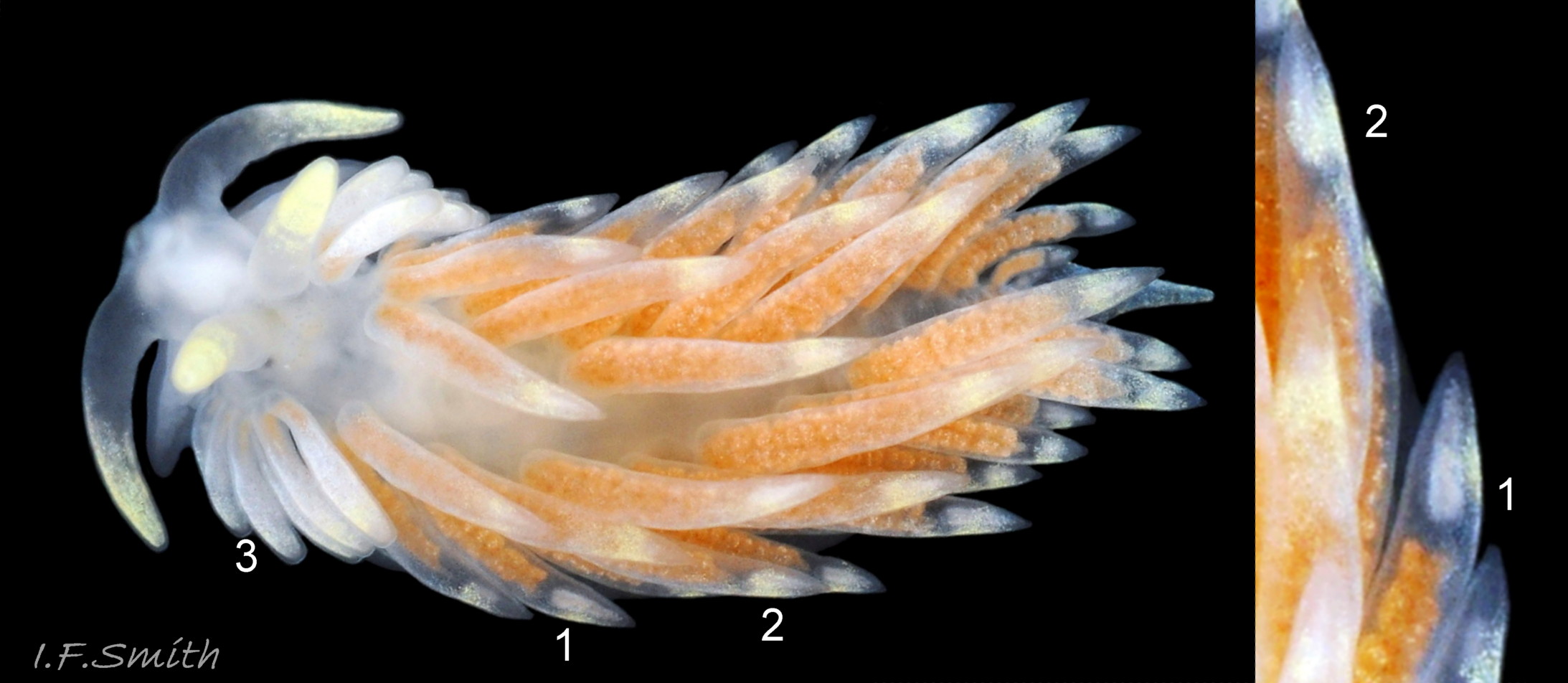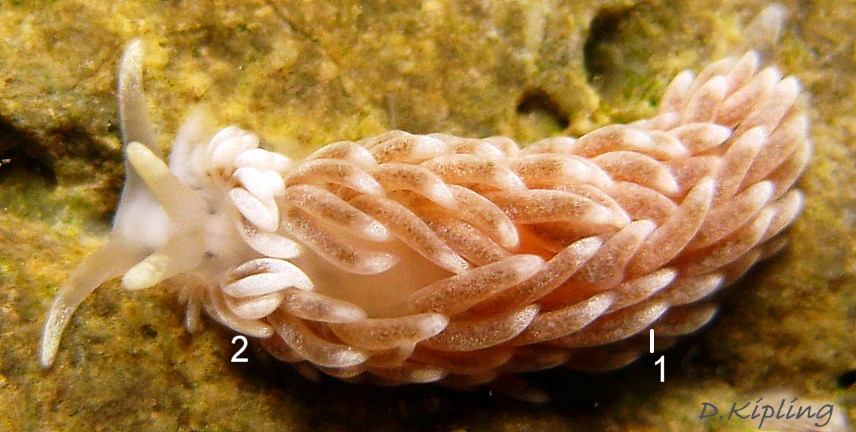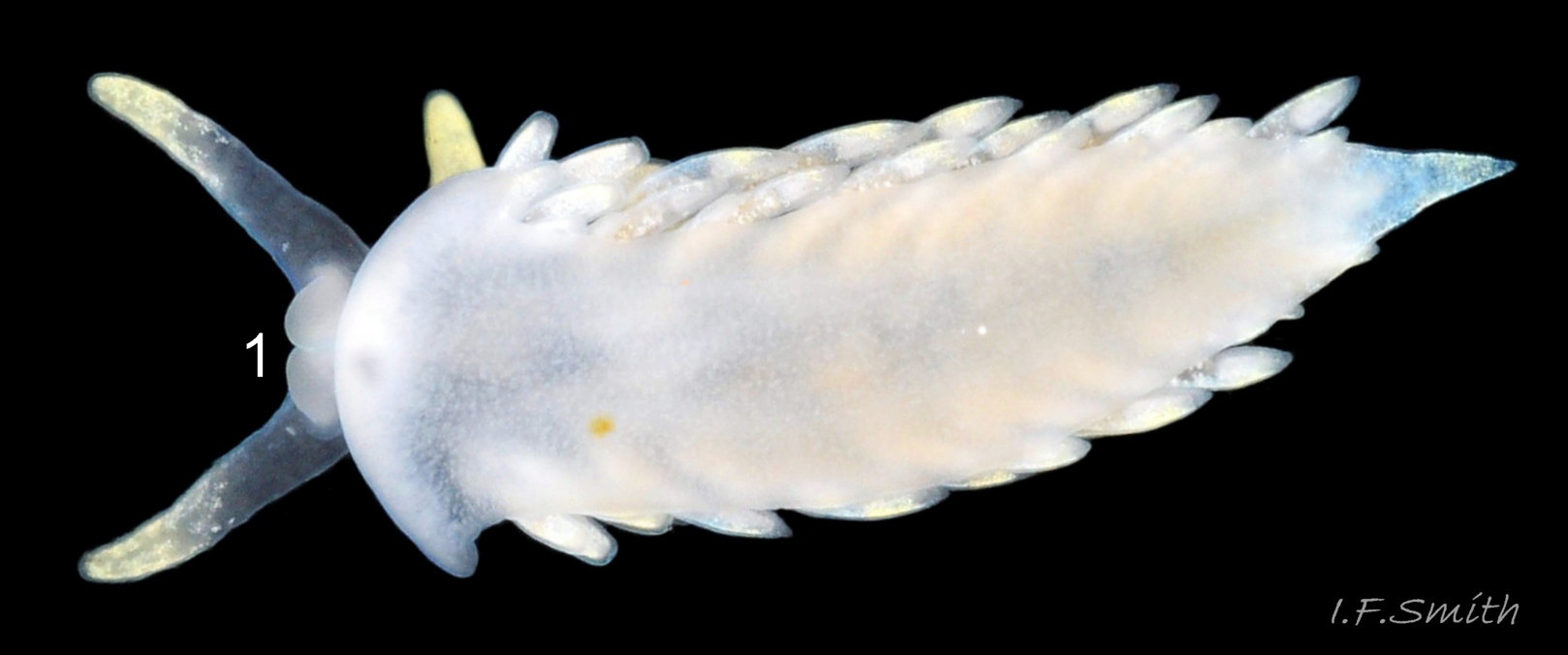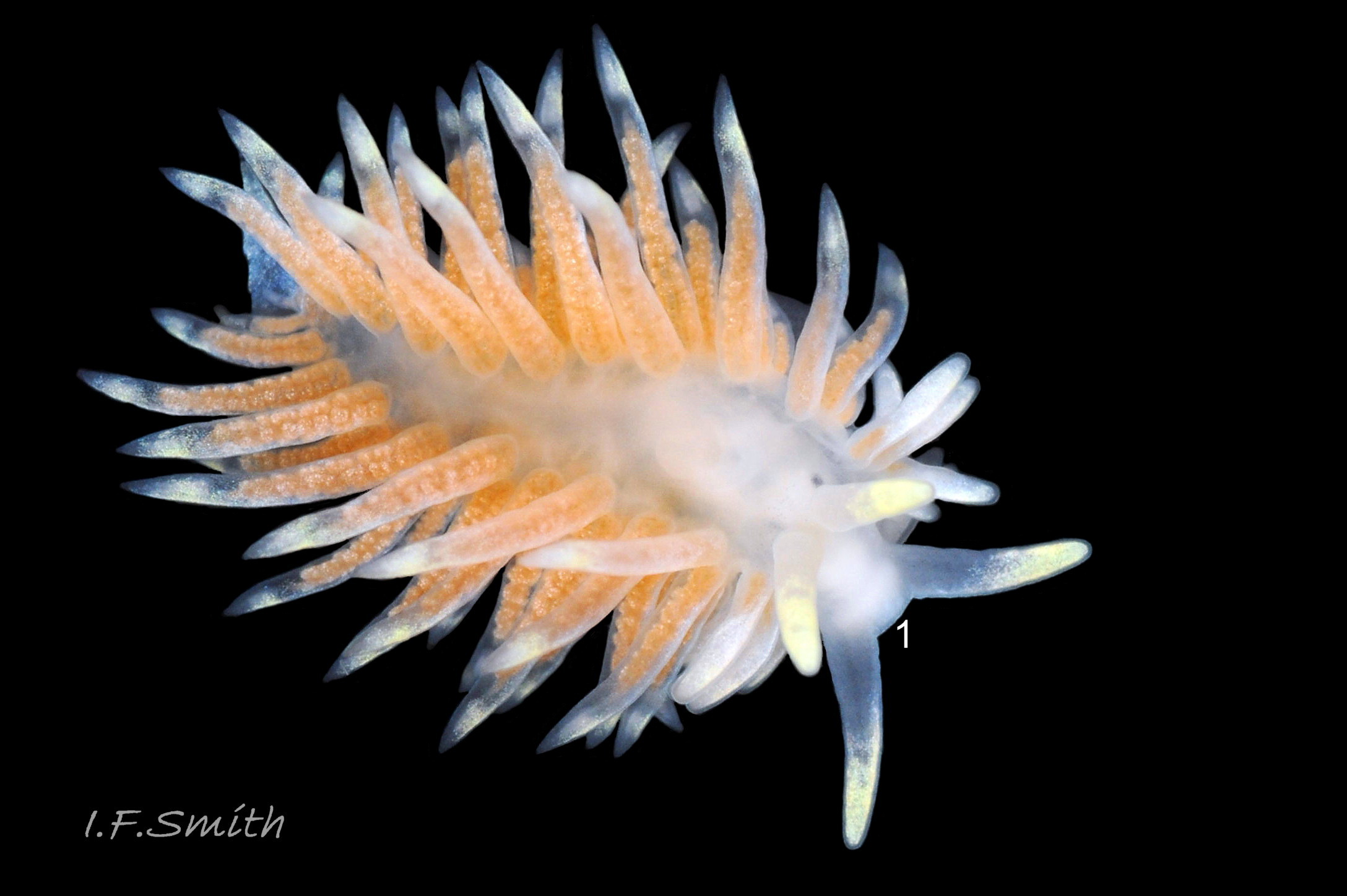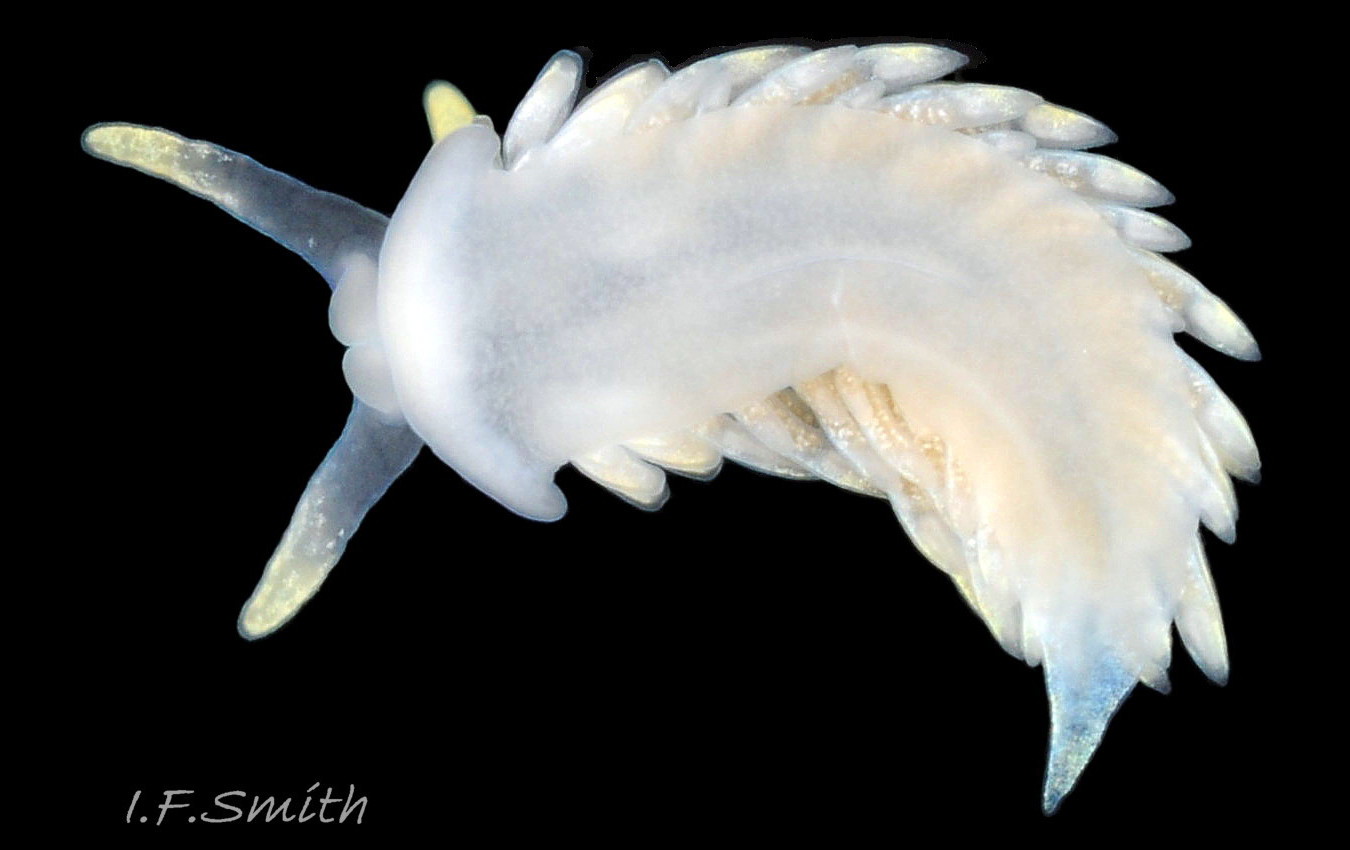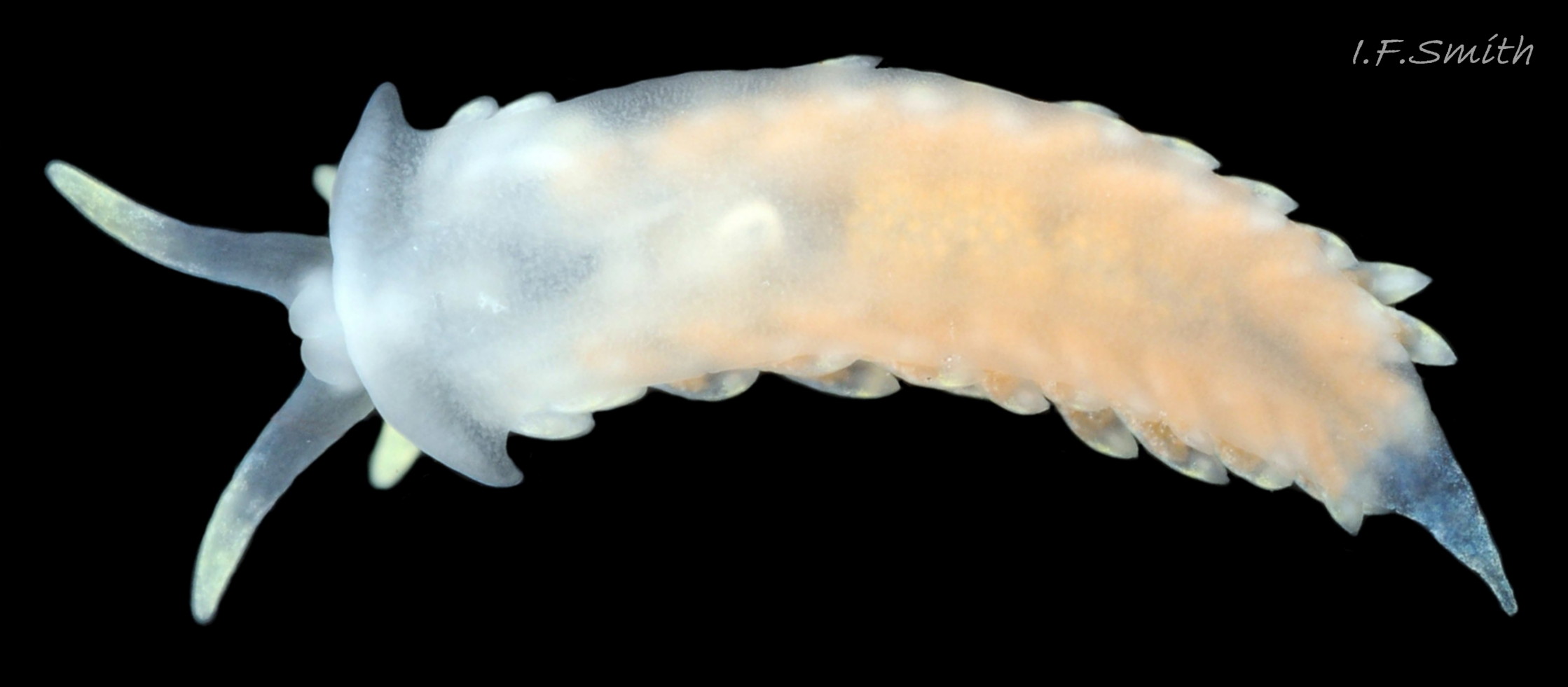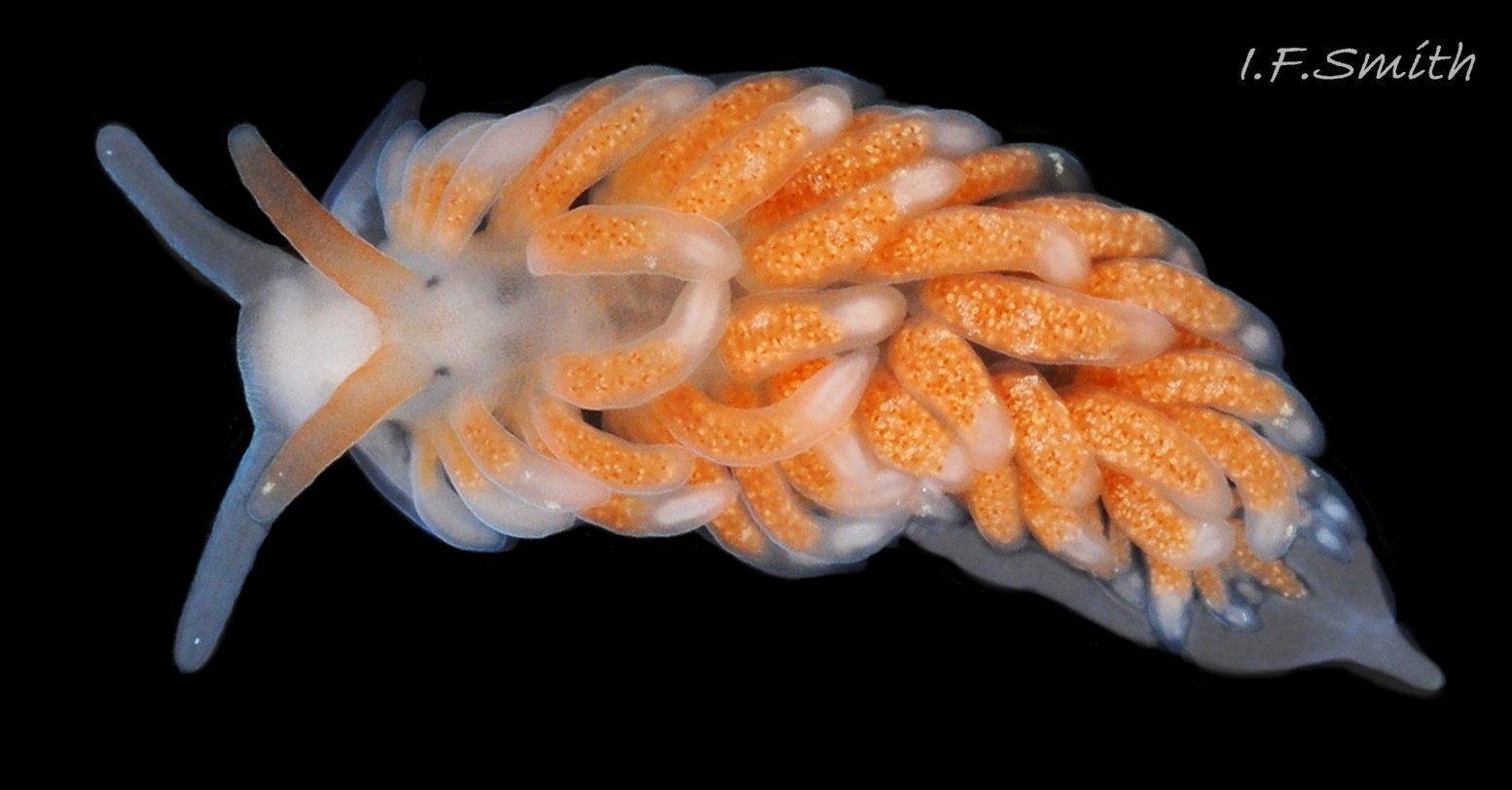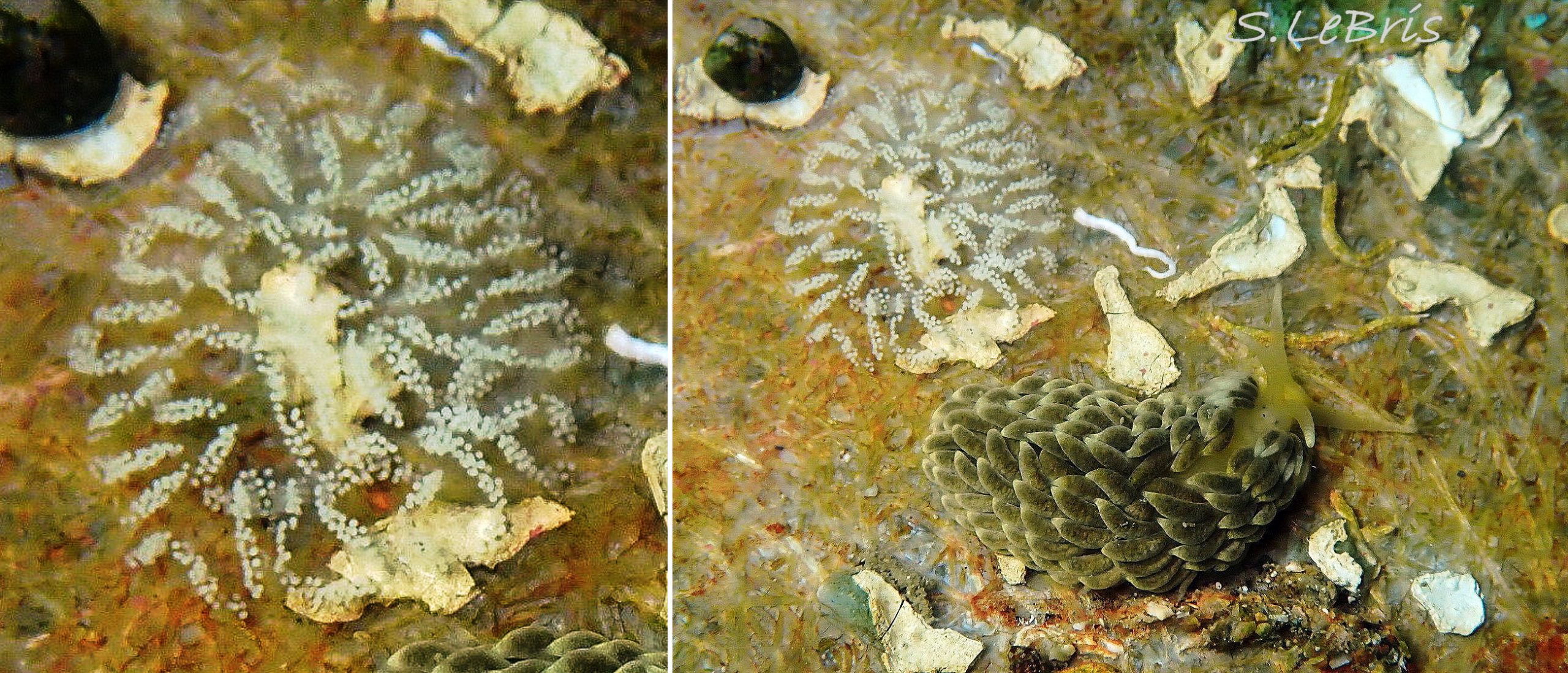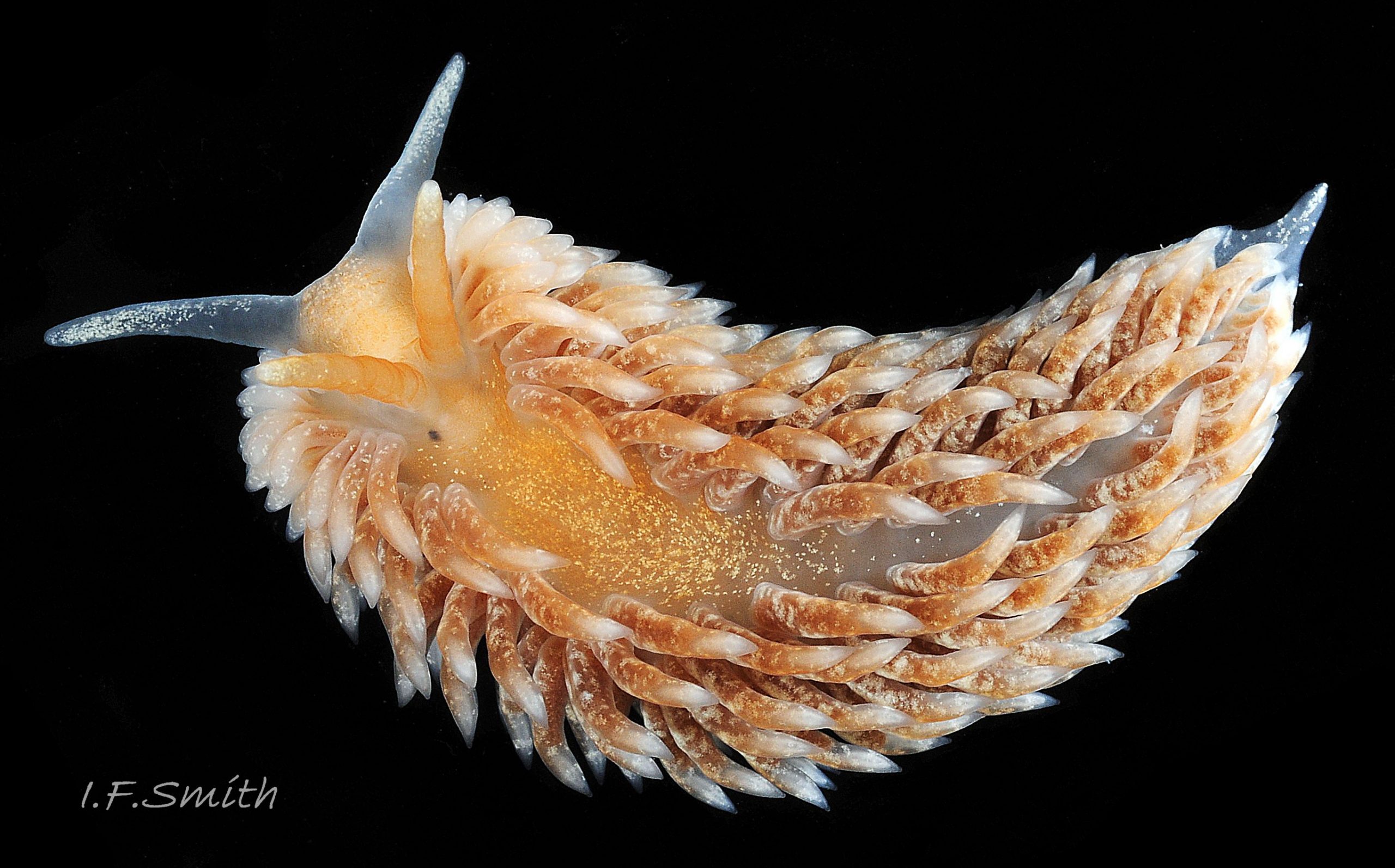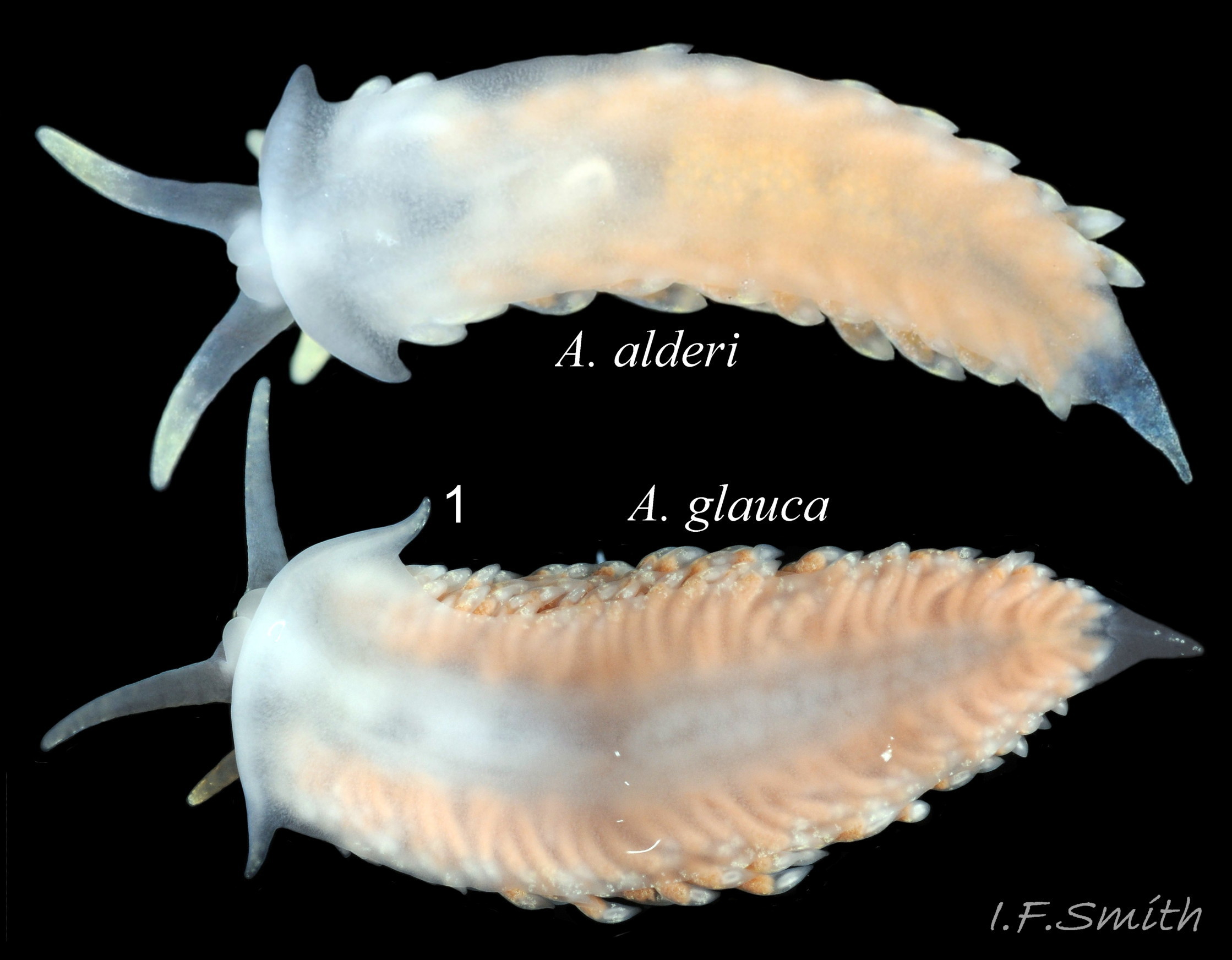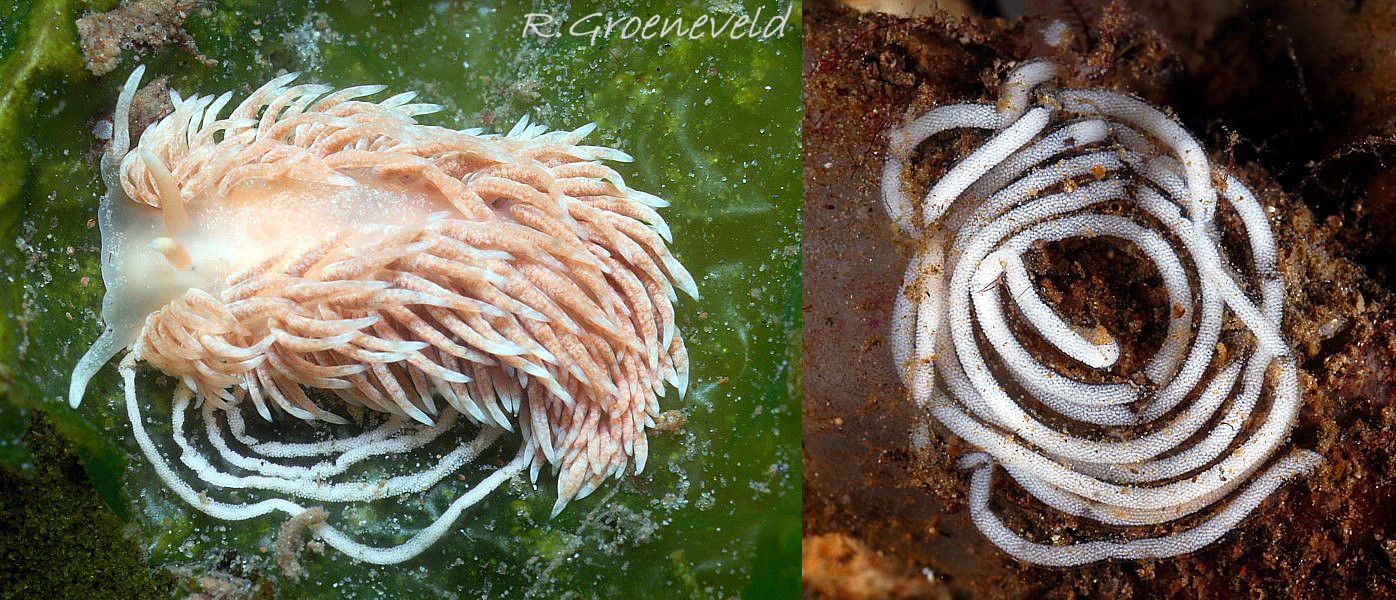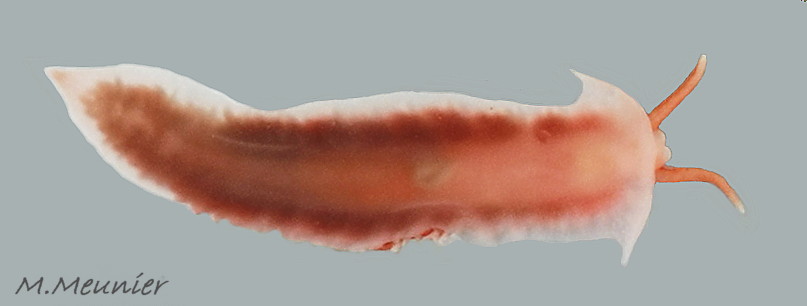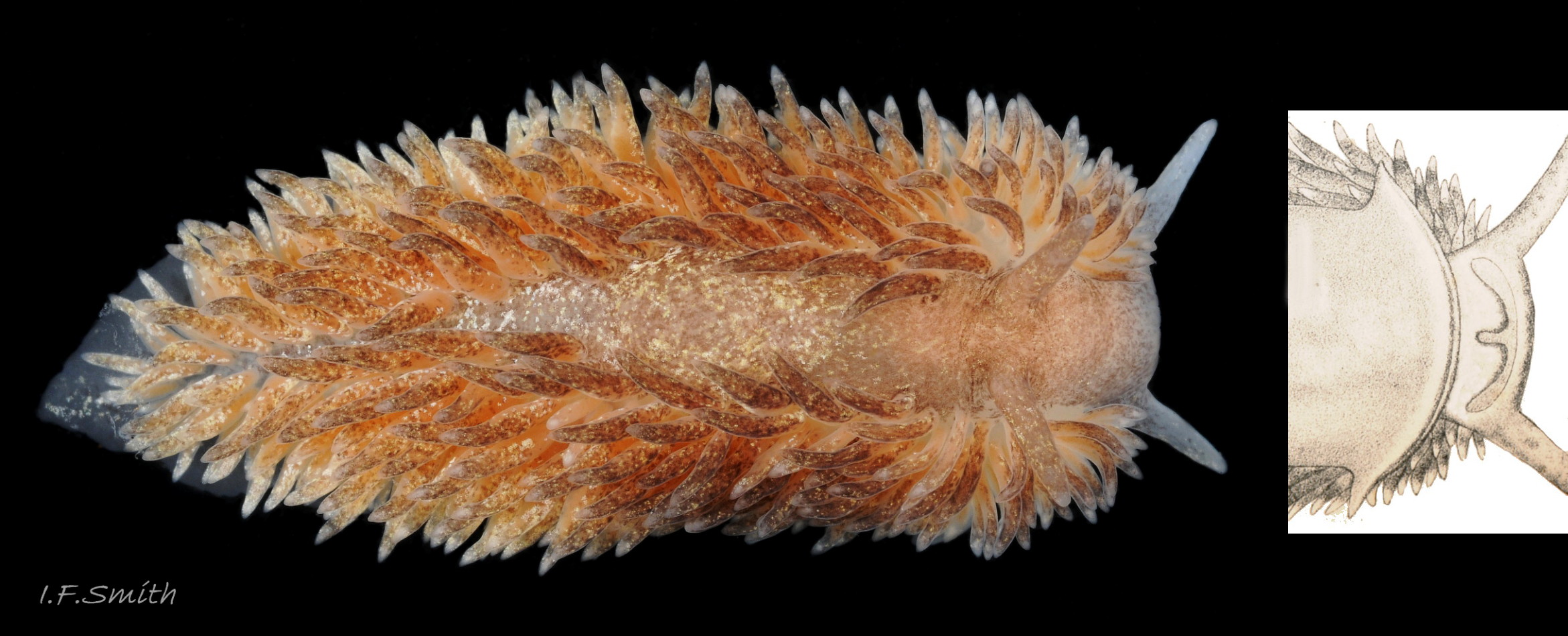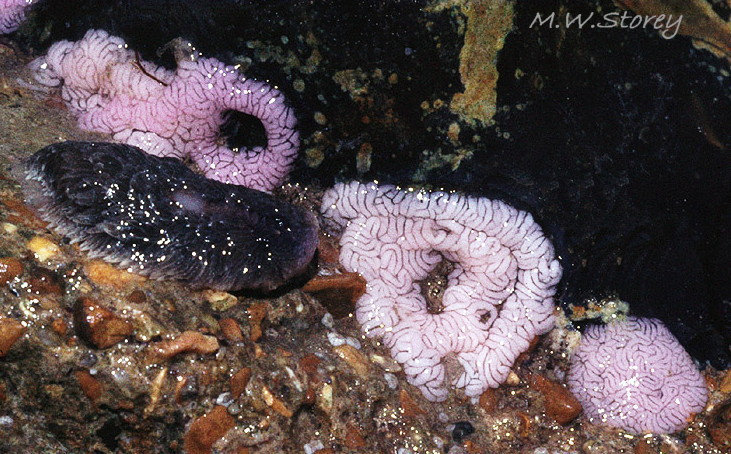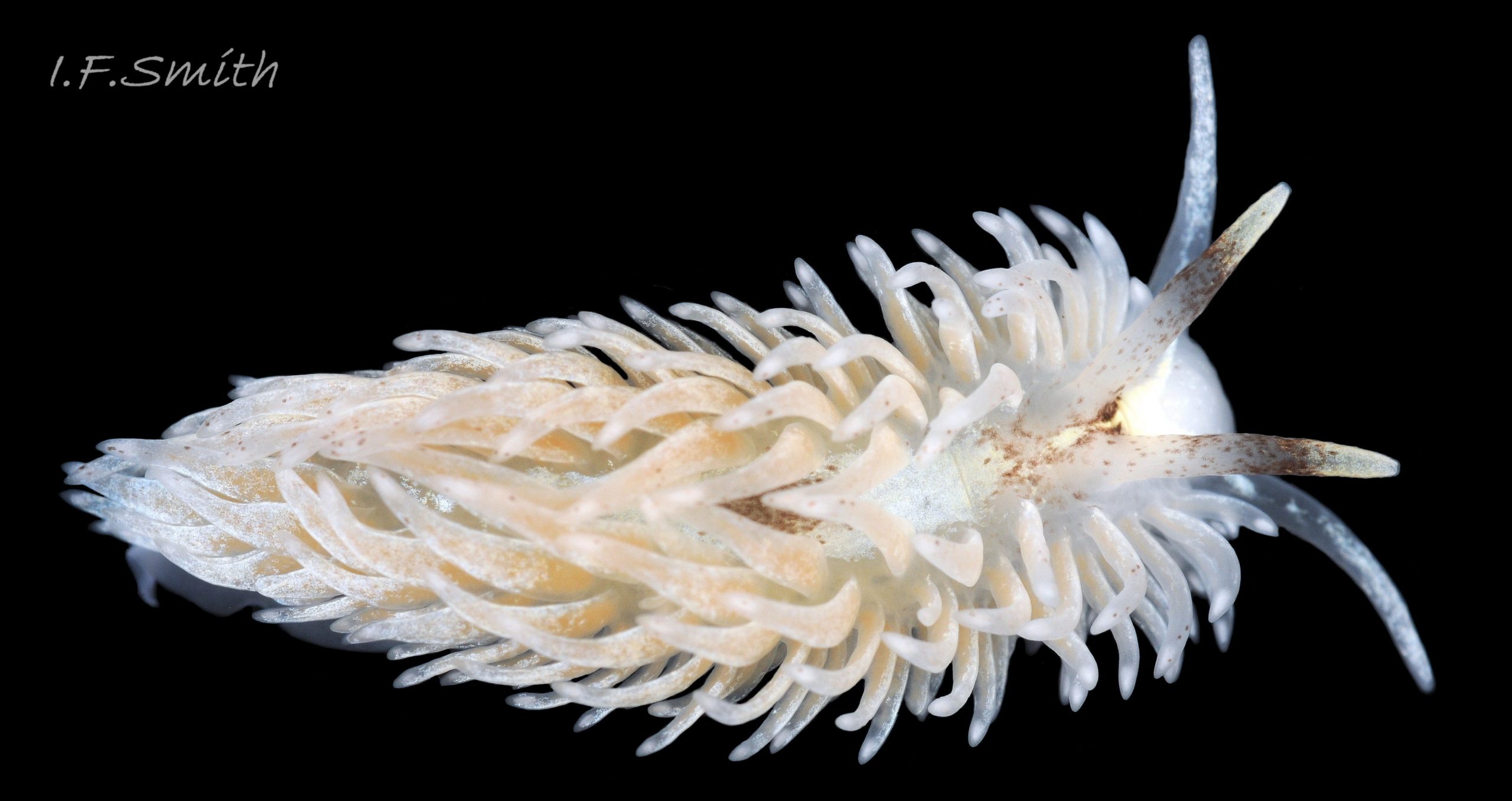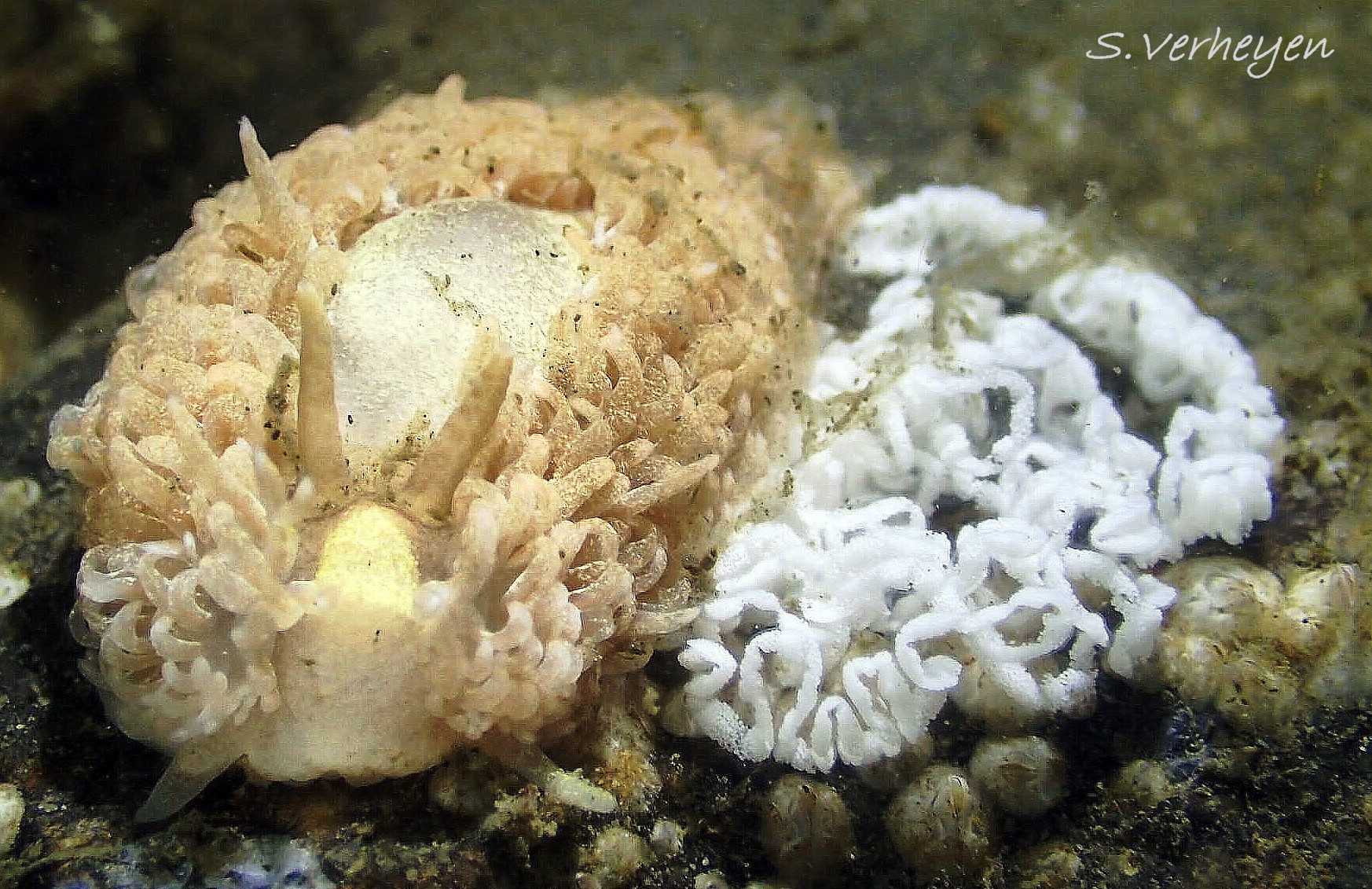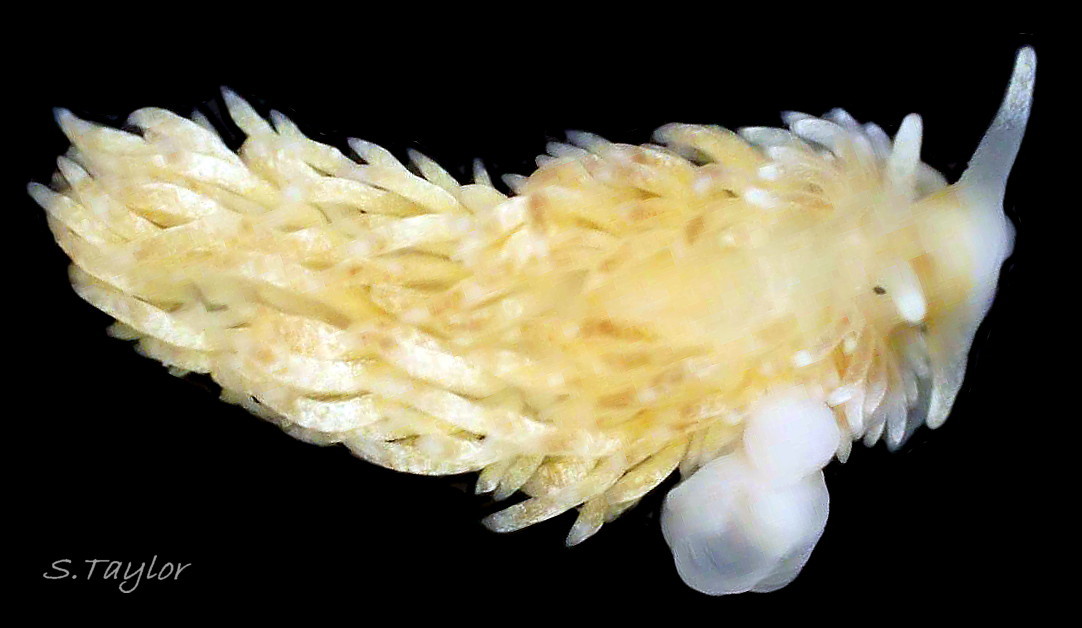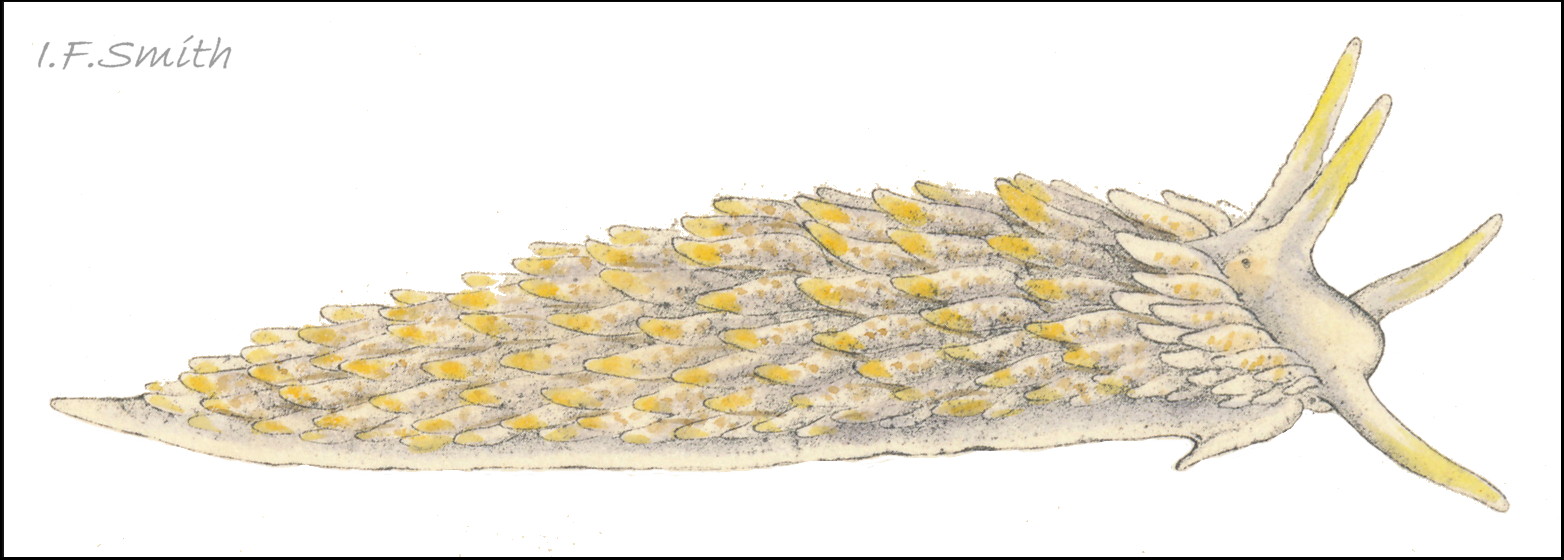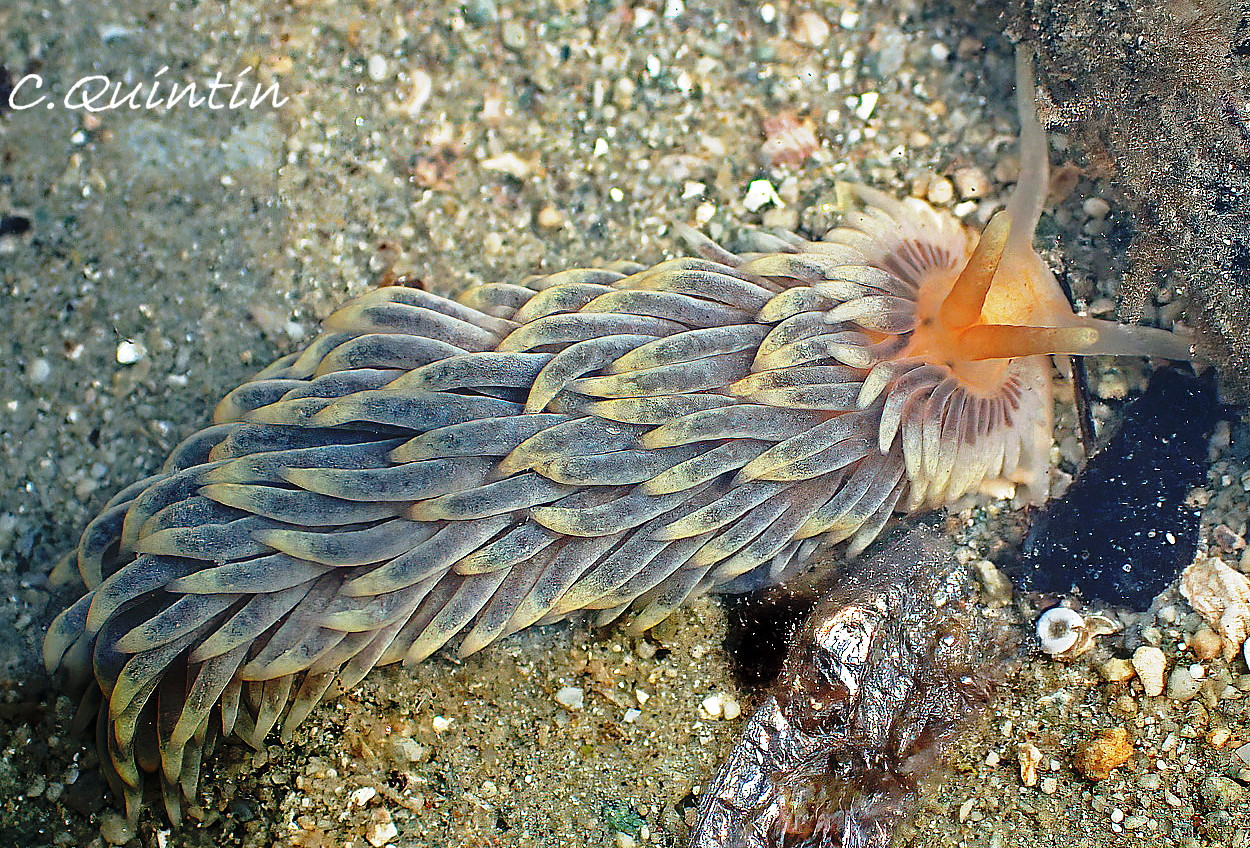Click image to enlarge with full caption. Main text below slider.
Aeolidiella alderi (Cocks, 1852)
PDF available at www.researchgate.net/publication/365130812_Aeolidiella_al…
Synonyms: Eolis alderi Cocks, 1852
Current taxonomy: World Register of Marine Species www.marinespecies.org/aphia.php?p=taxdetails&id=138710
GLOSSARY BELOW
Description
The body of A. alderi, excluding appendages, grows to a maximum length of 37 mm when fully extended (Thompson & Brown, 1984). Each individual can extend or contract to give a thin, elongate or broad, short outline when viewed from above 01 Aeolidiella alderi . The body is usually translucent white, sometimes revealing the pinkish ovotestes in the posterior half 02 Aeolidiella alderi and occasionally other white, internal organs such as the jaw, buccal mass, oesophagus, circum-oesophageal nerve ring and genitalia 03 Aeolidiella alderi . On some, the body is tinted yellowish 04 Aeolidiella alderi or red 05 Aeolidiella alderi but without any opaque flecks.
The cerata are arranged in up to fifteen obliquely transverse rows 06 Aeolidiella on each side of the body. They can be held at any angle between prone and vertical 07 Aeolidiella alderi & 08 Aeolidiella alderi . When the digestive gland is empty, the cerata are translucent white with a fine flecking of opaque white 09 Aeolidia alderi , but when the gland is full of granular matter 10 Aeolidiella alderi it gives its colour to the cerata. The resultant colours vary greatly with the colour of the sea anemones consumed. Occasionally the fine surface flecking is yellowish or bluish 02 Aeolidiella alderi . The apical zone above the digestive gland of each ceras is occupied by a large white cnidosac 10 Aeolidiella alderi which is sometimes obscured by opaque white or yellowish white flecks 11 Aeolidiella alderi . The anterior row of cerata has particularly large cnidosacs which fill from half to almost all of each ceras and often forms a conspicuous white ruff 05 Aeolidiella alderi .
The head is coloured as the body. The smooth rhinophores and oral tentacles are translucent white, sometimes tinted yellowish to reddish, with opaque white or yellow pigment distally 12 Aeolidiella alderi From above, black eyes are usually clearly visible at the posterior base of the rhinophores 12 Aeolidiella alderi except when hidden by the rhinophores tilted backwards 10 Aeolidiella alderi . The oral tentacles originate close to each other above the ventrally slit, outer lips of the mouth 12 Aeolidiella alderi which occupy most of the head ventrally 13 Aeolidiella alderi . The distance between the bases of the oral tentacles is about the same as the thickness of a single tentacle base. This is best gauged when the tentacles are angled forwards 14 Aeolidiella alderi or backwards 10 Aeolidiella alderi as it is difficult to differentiate the tentacle base from the front edge of the head when the tentacles are at right angles to the body 02 Aeolidiella alderi .
The foot is widest at the anterior where it forms a smooth crescent terminating in short triangular propodial tentacles 15 Aeolidiella alderi . It tapers rapidly near the posterior to a fine point. It is thin, white and translucent showing the colour of the cerata above 16 Aeolidiella alderi and sometimes, faintly, the ovotestes.
Key identification features
Identification should be made with more than one feature as there is some interspecific overlap. For example a white ruff of anterior cerata can be found on some of all three Aeolidiella species, though it is usually most distinct on A. alderi.
Aeolidiella alderi
1) Maximum length 37 mm (Thompson & Brown, 1984). When extended, fairly robust but more slender than Aeolidia papillosa, A. filomenae and Aeolidiella glauca. Usually straighter than the more slender, sinuous A. sanguinea.
2) From above, internal eyes usually visible through translucent body 12 Aeolidiella alderi but see 10 Aeolidiella alderi .
3) Front row of cerata makes a white ruff 05 Aeolidiella alderi & 30 Aeolidiella alderi . White zone in each ceras is usually 50% or more of length.
4) No opaque freckles on dorsum.
5) Distance between oral tentacles about same as thickness of single tentacle base 10 Aeolidiella alderi & 14 Aeolidiella alderi .
6) Anterior edge of foot a smooth crescent terminating in short triangular propodial tentacles 15 Aeolidiella alderi .
7) White or yellow pigment distally on rhinophores, oral tentacles and cerata 12 Aeolidiella alderi & 10 Aeolidiella alderi .
8) Body translucent white. Some tinted yellowish or reddish so may be confused with A. sanguinea 17 Aeolidiella alderi & 05 Aeolidiella alderi .
9) Spawn is a deeply sinuous line arranged loosely in a disc 18 Aeolidia alderi .
Similar species
Aeolidiella glauca(Alder & Hancock, 1845) 19 Aeolidiella alderi.
1) Maximum length 40 mm (Thompson & Brown, 1984). Broader than A. alderi 20 Aeolidiella alderi.
2) From above, internal eyes usually visible through translucent body.
3) Anterior cerata may be white and resemble white ruff on A. alderi but white zone in some cerata usually less than 50% of length.
4) Anterior half of body copiously speckled with pale opaque pigment.
5) Distance between oral tentacles about same as thickness of single tentacle base.
6) Anterior edge of foot has short propodial tentacles 20 Aeolidiella alderi.
7) White pigment speckles on oral tentacles, cerata and, distally, on rhinophores.
8) Body translucent white, anterior often translucent orange.
9) Spawn; a plain non-sinuous spiral line, white contents divided into sections by breaks 21 Aeolidiella alderi .
Aeolidiella sanguinea (Norman, 1877)
22 Aeolidiella alderi & 23 Aeolidiella alderi.
Some specimens are very difficult to confidently differentiate from A. alderi without molecular sequencing.
1) Maximum length 46 mm (Thompson & Brown, 1984). Slender sinuous body is more slender than A. alderi.
2) From above, internal eyes usually visible through translucent body.
3) All cerata have a large white cnidosac slightly tinted by the orange to red surface of the cerata. The front row of cerata can make a white ruff, and the white zone, tinted orange or red, in each ceras can be more than 50% of ceras length.
4) No opaque freckles on notum.
5) Distance between oral tentacles about same as thickness of single tentacle base.
6) Anterior edge of foot often sigmoid with short propodial tentacles
7) No surface pigment on tentacles or cerata, but rhinophores have distinctly demarcated white tips.
8) Body, rhinophores and cerata are translucent red, orange or yellow,
9) Spawn; a plain spiral line.
Aeolidia papillosa (Linnaeus, 1761)
1) Maximum length120 mm (Thompson & Brown, 1984). Body broader than Aeolidiella alderi.
2) Internal eyes not, or barely, visible through opaque pigment.
3) Dull whitish cnidosac visible if not obscured by white apical pigment.
4) Much opaque pigment on dorsum.
5) Distance between oral tentacles about three times thickness of tentacle base.
6) Anterior edge of foot a smooth crescent terminating in short triangular propodial tentacles.
7) Much pigment on rhinophores and cerata.
8) Most of body, rhinophores and cerata not translucent.
9) Spawn; large convoluted ribbon, standing upright in water, deposited in spiral 25 Aeolidiella alderi.
Aeolidia filomenae Kienberger, Carmona, Pola, Padula, Gosliner & Cervera, 2016.
26 Aeolidiella alderi.
1) Maximum length at least 70 mm. Body broader than Aeolidiella alderi .
2) Internal eyes sometimes faintly visible in light specimens.
3) Apices of cerata are white, often revealing large white cnidosacs.
4) Dorsum white or pale colour with opaque white or brown flecks which may concentrate locally into dense brown markings.
5) Distance between oral tentacles about three times thickness of tentacle base.
6) Anterior edge of foot a smooth crescent terminating in short triangular propodial tentacles.
7) Rhinophores and cerata are translucent with varying amounts of opaque white and brown freckling.
8) Some parts of body and cerata may be translucent.
9) Spawn; large convoluted ribbon, standing upright in water, deposited in spiral 27 Aeolidiella alderi
Habits and ecology
A. alderi lives on the lower shore and shallow sublittoral, often where the substrate is a mixture of hard and soft substrate. Thompson and Brown (1984) listed its prey as the sea anemones Actinothoe sphyrodeta (Gosse, 1858), Cereus pedunculatus (Pennant, 1777), Metridium senile (Linnaeus, 1761), Diadumene cincta Stephenson, 1925, Cylista troglodytes (Price in Johnston, 1847), Cylista elegans (Dalyell, 1848), Sagartiogeton lacerata (Dalyell, 1848) and Paractinia striata (Risso, 1826) . Before feeding, the anterior white ruff of cerata may elongate and shoot nematocysts into the prey (Tardy 1964 in Thompson & Brown, 1984). It is an active species, readily raising its cerata to any perceived threat 08 Aeolidiella alderi & 14 Aeolidiella alderi .
Like other nudibranchs it is a simultaneous hermaphrodite. For mating the large genitalia are everted from behind the right rhinophore 28 Aeolidiella alderi . The distinctive spawn mass is a deeply sinuous line arranged loosely in a disc. The easily seen sections containing large, white ova each form large radiating loops which are separated by virtually invisible sections lacking ova 18 Aeolidia alderi . The total effect somewhat resembles the petals of a flower. Unlike A. glauca and A. sanguinea, which have a free living planktonic veliger stage, crawling juveniles emerge from the spawn.
Distribution and status
A. alderi occurs from the Mediterranean to Britain, GBIF map www.gbif.org/species/2291945 . Most records in Ireland are from the south and west coasts and, in Britain, from the south coast of England and up the west coast as far north as Anglesey. There is some uncertainty because of confusion with other Aeolidiella spp. and the species may be spreading with global warming. Scottish records, especially those on the cold east coast, need substantiating with clear photographs
NBN UK Map species.nbnatlas.org/species/NBNSYS0000173622# .
Acknowledgements
For use of images I thank Graham Day, Guy Freeman, Rokus Groeneveld, David Kipling, Sylvain Le Bris, Guillaume Lemonnier, Mathias Meunier, Christophe Quintin, Malcolm Storey, Simon Taylor, Lou Valence and Stefan Verheyen.
References and links
Alder, J. & Hancock, A. 1845-1855. A monograph of the British nudibranchiate mollusca. London, Ray Society. Family 3, Plate 10, [Figs 5 & 6 only]
29 Aeolidiella alderi .
www.biodiversitylibrary.org/item/131598#page/320/mode/1up
Groeneveld, R. & Reijs, S. Dutch Sea slugs www.diverosa.com/FF_NL/ff_zeenaaktslakken.htm
Thompson, T.E. & Brown, G.H. 1984. Biology of opisthobranch molluscs 2. London, Ray Society.
Glossary
buccal mass = anterior of digestive system including an odontophore that supports anterior of radula, and a complex of muscles to operate them and other mouthparts.
cerata = (sing. ceras, adj. ceratal) lobes on notum of some nudibranchs.
circum-oesophageal nerve ring = ganglia-bearing nerve cord which encircles the oesophagus.
Cnidaria = hydroids, jellyfish, sea anemones etc. which possess cnidocytes.
cnidocytes = explosive stinging cells of Cnidaria. en.wikipedia.org/wiki/Cnidocyte
cnidosac = storage capsule at tips of cerata of Aeolidiidae for ingested cnidocytes.
digestive gland = large organ in gastropods which acts like the liver and pancreas in mammals to absorb food.
distal = away from centre of body or from point of attachment.
hermaphrodite, simultaneous = individual acts as both male and female at the same time with similar partner.
molecular sequencing = technique for determining the sequence of the bases adenine, guanine, cytosine, and thymine (A, G, C and T) in a DNA molecule.
notum = (of sea slugs) the dorsal surface of the body; the back.
ovotestis = (pl. ovotestes) hermaphrodite organ serving as both ovary and testis.
propodial tentacles = tentacular, lateral extensions on anterior of the foot.
rhinophore = chemo-receptor tentacle; many sea slugs have a pair on top of the head.
sensu lato = (abbreviation s.l.) in the wide sense, possibly an aggregate of more than one species.
sensu stricto = (abbreviation s.s.) in the strict sense, excluding species that have been aggregated or confused with it.
veliger = shelled larva which moves by action of cilia on a velum (bilobed flap). Stage may be passed in plankton or within liquid-filled egg-capsule.

